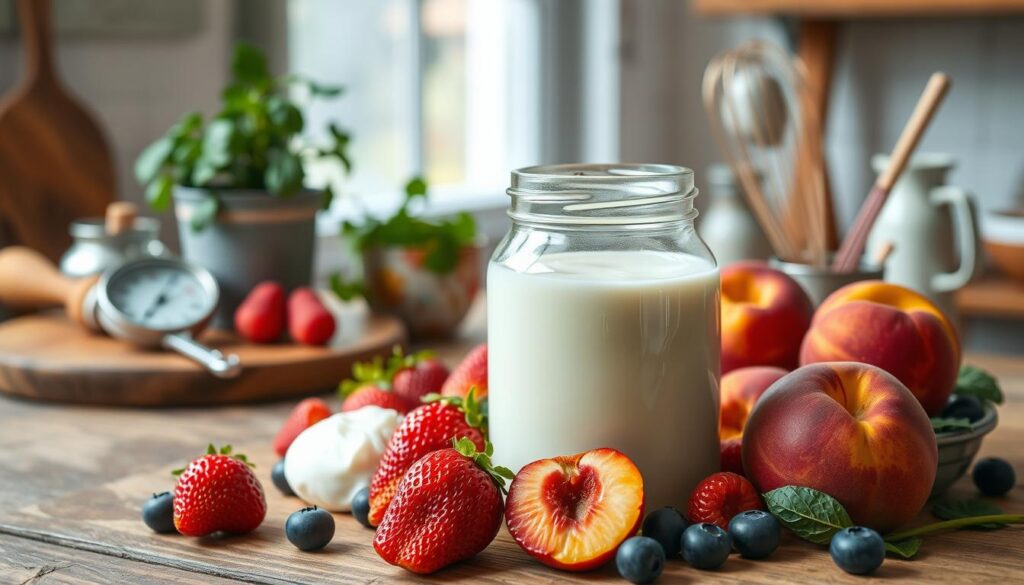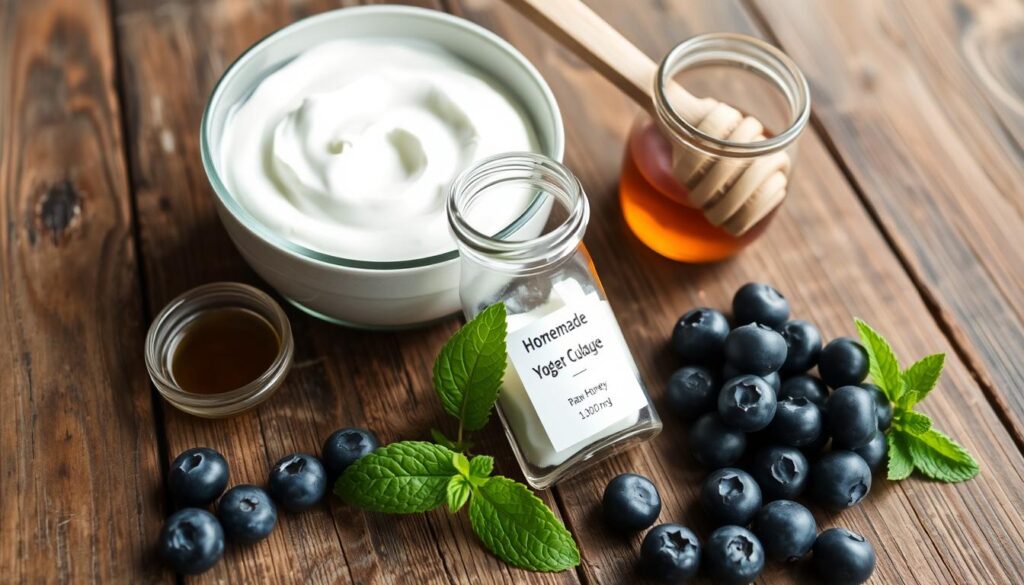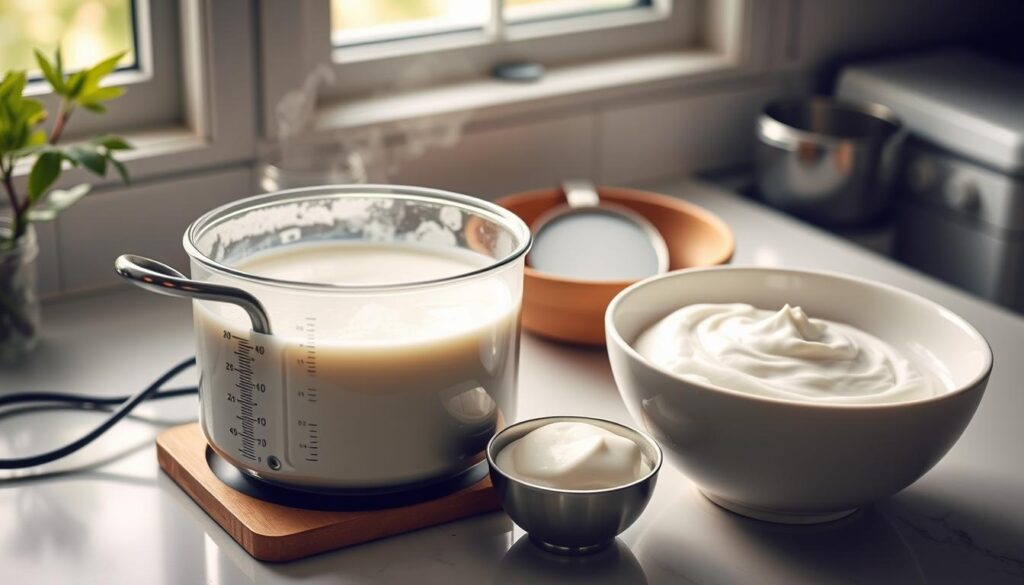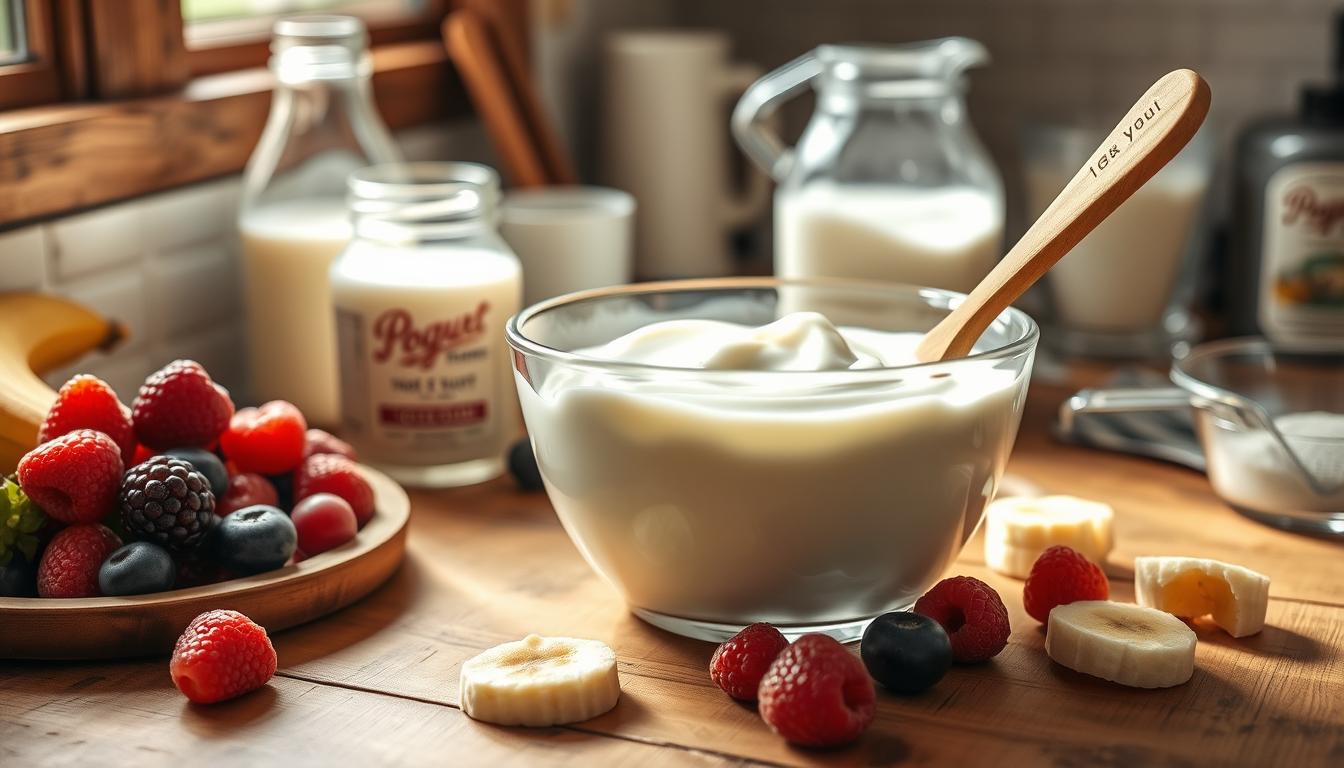Making yogurt at home is a fun and rewarding experience. It lets us enjoy creamy, tangy flavors just the way we like them. We’ll learn how homemade yogurt boosts our health and adds variety to our meals.
By mastering this simple recipe, we can make yogurt that’s perfect for us. We’ll feel proud of making it ourselves. This guide will help us understand the right yogurt ratio and more.

Key Takeaways
- Making ratio yogurt at home is simple and fulfilling.
- Homemade yogurt can be tailored to individual tastes and dietary needs.
- Understanding perfect yogurt ratios is key to achieving optimal flavor and texture.
- Homemade yogurt is versatile in recipes and meal preparations.
- Enjoy the health benefits of probiotics found in fresh yogurt.
Understanding Ratio Yogurt
Ratio yogurt is about the right mix of ingredients in making yogurt. This mix affects the taste and feel of the yogurt. Getting the right balance is key to making a creamy and tangy yogurt that we love.
When making yogurt, mixing milk and starter culture is crucial. The usual method involves specific ratios to get a consistent taste. For instance, using one part starter culture to four parts milk is common. This mix starts fermentation and adds a nice tang and richness to our yogurt.
The table below shows some common yogurt ratios and what they produce:
| Milk Type | Starter Culture Amount | Yogurt Texture | Flavor Profile |
|---|---|---|---|
| Whole Milk | 1/4 cup | Creamy | Rich and Tangy |
| 2% Milk | 1/4 cup | Smooth | Balanced |
| Skim Milk | 1/4 cup | Thinner | Mild |
By tweaking these ratios, we can make yogurt that fits our taste. Learning about these ingredients makes the yogurt-making process more fun and fulfilling.

Benefits of Making Yogurt at Home
Making yogurt at home brings many benefits to our cooking. One big plus is the nutritional value. Homemade yogurt often has more probiotics, which is good for our stomachs. We can also avoid added sugars and artificial stuff found in store yogurt.
It’s also cheaper to make yogurt at home. The benefits of homemade yogurt include saving money over time. Plus, it helps us use less packaging, which is better for the planet.
Many people enjoy making yogurt from scratch. It’s a fun way to try new flavors and techniques. Our homemade yogurt recipe is not just healthy but also special to us.

Gathering Our Ingredients
To start making homemade yogurt, we need to get the right ingredients. The type of milk we choose is key. It affects the yogurt’s texture and taste. We can pick from whole milk for creaminess, low-fat for a lighter version, or non-fat for a healthier option.
Choosing a good starter culture is also important. Our top picks are:
- Plain yogurt with live active cultures, like Chobani or Fage
- Commercial yogurt starters such as Yogourmet which guarantee the desired bacterial strains
Using these ingredients will help our homemade yogurt turn out great. Here’s a table that shows what each ingredient does:
| Ingredient | Type | Effect on Yogurt |
|---|---|---|
| Whole Milk | Fat content: 3.5%+ | Rich and creamy texture |
| Low-Fat Milk | Fat content: 1-2% | Light texture, slightly tangier flavor |
| Non-Fat Milk | Fat content: | Lighter texture, less creamy |
| Plain Yogurt | No added sugars or flavorings | Jumpstarts fermentation, adds tanginess |
| Commercial Yogurt Starter | Specific bacterial cultures | Consistent results, easier option |
With these ingredients, we’re ready to make creamy, tasty yogurt at home.

Ratio Yogurt at Home: Step-by-Step Guide
Starting to make yogurt at home means knowing a few key things. We’ll talk about picking the right milk, the role of starter culture, and finding the perfect yogurt ratios.
Choosing the Right Milk
There are many types of milk to choose from for yogurt. Whole milk makes it creamy, while skim milk makes it lighter. The taste can change based on the milk type, like dairy or plant-based. It’s fun to try different ones to see what you like best.
Starter Culture Essentials
Choosing the right starter culture is important. We often use plain yogurt with live cultures or special yogurt starters. These cultures start the fermentation process, which is key for the yogurt’s taste and texture.
Perfect Yogurt Ratios Explained
Knowing the right yogurt ratios is key for success. A common mix is four cups of milk to two tablespoons of starter culture. You can tweak this to get the thickness and taste you want. This knowledge lets you make yogurt just the way you like it, with the right balance of creaminess and tanginess.

Preparing Your Yogurt Making Setup
Creating a successful yogurt making setup is key to getting that perfect creamy texture. Our DIY yogurt guide will show you the essential yogurt equipment for a smooth process. Here’s a detailed list of tools you’ll need:
- Pots (stainless steel preferable)
- Thermometers (for accurate temperature control)
- Containers (glass or BPA-free plastic for storage)
- Yogurt maker (optional, but highly recommended)
- Whisk or spoon (for mixing ingredients)
- Oven or cooler (as creative alternatives for a yogurt making setup)
Temperature control is crucial in yogurt fermentation. We aim for a stable temperature, usually between 110°F and 115°F. If you don’t have a yogurt maker, use an oven with the light on or a cooler with warm water. Both methods keep the heat steady, perfect for our yogurt.
Getting ready is essential for yogurt success. Having the right equipment avoids problems and makes the process better. With everything set, we’re ready to make our tasty homemade yogurt!
The Yogurt Making Process
Making delicious yogurt is a step-by-step process. It involves heating the milk and adding a starter culture. Each step is crucial for the right texture and taste.
Heating the Milk
We begin by heating the milk. This step is key for making the yogurt creamy. We heat it to about 180°F (82°C). Keeping it at this temperature for a few minutes is important.
Cooling and Adding the Starter
After heating, we cool the milk to 110°F (43°C). Then, we add the starter culture. We mix it well to spread the cultures evenly. This starts the fermentation, turning our ingredients into yogurt.
Fermentation: The Key to Creaminess
The fermentation process is key in making our milk into creamy yogurt. During this time, good bacteria from the starter culture eat lactose, making lactic acid. This acid thickens the yogurt and adds a tangy flavor we all enjoy.
To get the right creamy yogurt, we aim for 6 to 12 hours of fermentation. The best temperature for this is between 110°F to 115°F. Keeping it warm helps the bacteria grow well, turning milk into yogurt.
Our kitchen’s temperature also affects fermentation. Cooler rooms need longer time, while warmer ones speed it up. Being patient and watching the yogurt closely is important.
Yogurt fermentation can sometimes face challenges. If it’s not set after the suggested time, we can wait longer. But if it’s too sour or runny, it’s fermented too long. Knowing how fermentation works helps us fix any problems.
Checking for Yogurt Doneness
To know if our yogurt is done, we need to look and taste it. We check its texture and flavor. This helps us decide if it’s ready or if we need to keep fermenting.
Understanding Texture and Taste
When we start checking, we look for certain signs. A thick, creamy texture means it’s fermented well. Whey separating from the solids is another sign it’s done.
Here are some important things to check:
- Firmness: Good yogurt is firm, not runny.
- Separation of Whey: A clear watery layer on top means it’s fermented enough.
- Aroma: A tangy, nice smell means the bacteria worked well.
- Taste: A small taste lets us adjust the flavor. It should be tangy but balanced.
Using our senses helps us make the perfect yogurt. By looking and tasting, we get yogurt that tastes just right to us.
Storing Our Homemade Yogurt
Making homemade yogurt takes time and effort. Storing it right is key to keep its taste and charm. Good storage keeps the flavor and lets us enjoy it longer. Here are the best ways to store homemade yogurt for freshness and quality.
Best Practices for Freshness
To keep our yogurt fresh and tasty, follow these tips:
- Airtight Containers: Use airtight containers to store yogurt. This keeps air and contaminants out, making it stay fresh longer.
- Refrigeration: Keep yogurt in the fridge at a steady temperature below 40°F. Don’t store it in the door, where temperatures change a lot.
- Freezing Options: For longer storage, freeze it. Use containers or ice cube trays that are safe for the freezer. This way, we can thaw only what we need.
- Check for Spoilage: Watch for signs of spoilage. If the smell, texture, or color changes, it’s time to throw it away.
By following these steps, our homemade yogurt will stay as good as the day we made it.
Flavoring Our Ratio Yogurt
Flavoring yogurt opens up a world of delicious possibilities. We can turn our homemade yogurt into a culinary delight. From sweet to savory, the options are endless. Whether it’s a refreshing snack or a rich dessert, the choices are limitless.
We can add natural ingredients directly into our yogurt. This can happen during or after making it. Here are some fantastic ingredients we can use:
- Fresh Fruits: Strawberries, blueberries, peaches, or mangoes add natural sweetness and vibrant flavor.
- Spices: Cinnamon, vanilla, or nutmeg can create warm, inviting taste sensations.
- Natural Sweeteners: Honey or maple syrup allows us to sweeten our yogurt without refined sugars.
- Cocoa Powder: A touch of cocoa can introduce a rich chocolate flavor for dessert lovers.
- Herbs: Fresh mint or basil can lend a unique twist to savory yogurt preparations.
The method we choose to incorporate these flavors depends on personal preference. Here are some ways to include flavors:
- Add fruit puree to the milk before the starter culture to blend flavors thoroughly.
- Mix spices and sweeteners into yogurt after fermentation for a fresh burst of flavor.
- Layer flavored yogurt with granola or nuts to create a beautiful parfait.
To help visualize these flavors, consider the following table showcasing examples of combinations:
| Flavor Base | Ingredient Suggestions | Best For |
|---|---|---|
| Fruity | Strawberries, Bananas, Raspberries | Breakfast, Snacks |
| Spiced | Cinnamon, Ginger, Nutmeg | Desserts, Smoothies |
| Chocolate | Cocoa Powder, Dark Chocolate Chips | Special Treats |
| Savory | Cucumber, Garlic, Dill | Dips, Savory Meals |
By experimenting with these options, we can create a range of tasty and healthy yogurt flavors. Making a homemade yogurt recipe allows us to personalize our experience. We can enjoy this nutritious treat in endless ways.
Conclusion
Making yogurt at home lets us control what goes into it. It also gives us a great feeling of accomplishment. We’ve shown you how to make perfect yogurt by following key steps.
Yogurt is good for our digestion and we can flavor it however we like. This makes making yogurt a rewarding task.
Let’s all try making different kinds of yogurt. We can add fruits, spices, or sweeteners to make it our own. Homemade yogurt is flexible, so we can make it simple or fancy.
We want to hear about your yogurt-making adventures. Your stories help our community grow and inspire others. Let’s enjoy making homemade yogurt together and keep discovering new things!
FAQ
What is ratio yogurt, and why is it important?
Ratio yogurt is about the right mix of milk and starter culture. It makes our homemade yogurt smooth and tangy. Knowing the perfect mix is key for great results.
How do I choose the right milk for making yogurt?
We can pick from whole, low-fat, or non-fat milk. Whole milk makes yogurt creamier, while lower-fat milks are lighter. Trying different milks helps us find our favorite.
What starter culture should I use for homemade yogurt?
Use plain yogurt with live cultures or commercial starters. Choose a high-quality brand for the best results.
How long should I ferment my yogurt?
Fermentation takes 6 to 12 hours at a steady temperature. The tanginess and thickness we want guide the time. Keep an eye on it for the perfect flavor.
What tools do I need for the yogurt-making setup?
You’ll need a heavy pot, thermometer, and containers. A yogurt maker helps, but you can also use an oven or cooler. This makes making yogurt easy and flexible.
How can we flavor our homemade yogurt?
Add fruits, spices, or sweeteners to flavor. You can mix them in during making or add later. This lets you create many different flavors.
How should we store our homemade yogurt to ensure freshness?
Store it in airtight containers in the fridge. Freezing is also an option. Knowing when it’s gone bad is important for safety.
What are the health benefits of making yogurt at home?
Homemade yogurt has more probiotics and less added sugar. It’s also cheaper than store-bought. This makes it a healthier choice.
Can I use non-dairy milk to make yogurt?
Yes! Use almond, soy, or coconut milk. You might need thickeners like agar or tapioca starch for the right texture.

